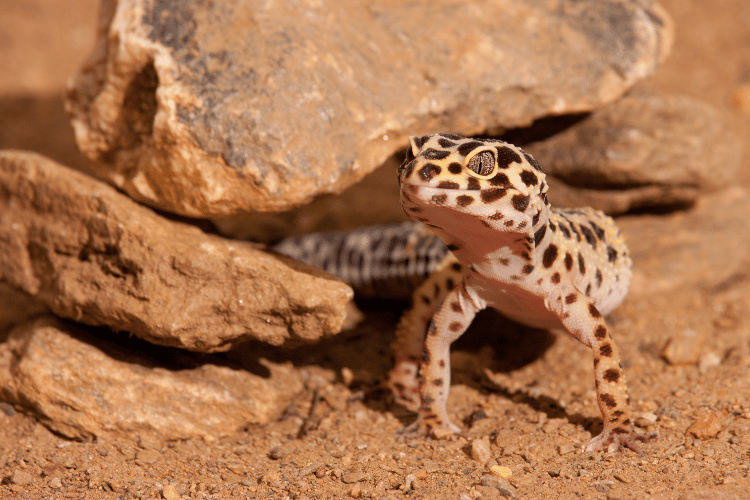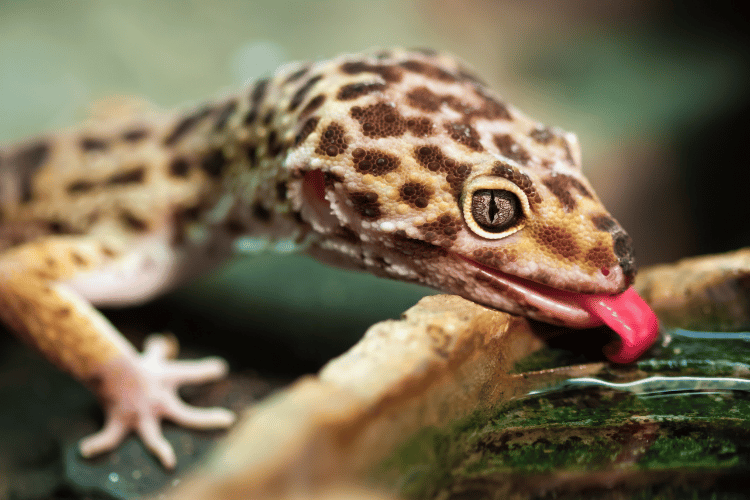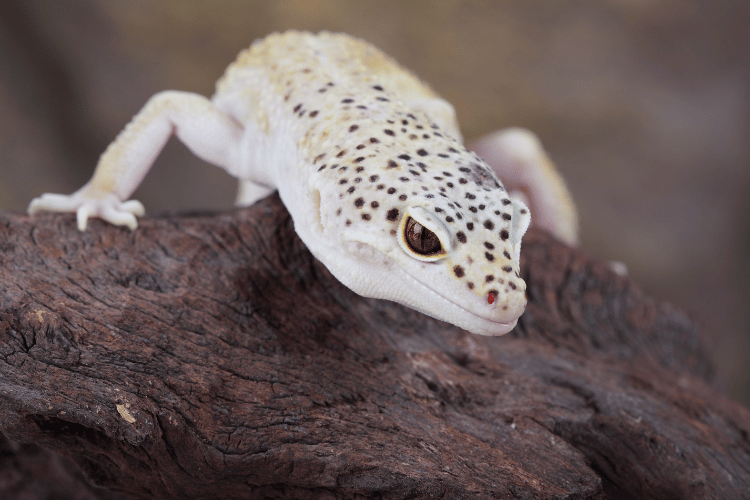Despite popular belief, leopard geckos can suffer from dehydration – just like other pets.
Although it’s a resilient lizard with outstanding adaptability, your leopard gecko is still vulnerable to reptile health problems, including dehydration.
This is a potentially life-threatening condition, so knowing how to deal with a dehydrated leopard gecko is part of your responsibility as an owner.
Today’s guide walks you through the signs, causes, effects, treatment, and prevention of dehydration in leopard geckos.

What Does Dehydration Look Like in Leopard Geckos?
Dehydration in leopard geckos is the same as it is in any other living creature; a lack of water/moisture inside the body.
Providing enough fresh water and misting the enclosure regularly is vital to support the overall health of your leopard gecko.
While leopard geckos can go on without drinking water for a long time as they’re able to absorb moisture from food and their environment, they can get dehydrated and show the following symptoms:
Behavioral Signs
The first sign of dehydration you should notice in the behavior of your pet leopard gecko is excessive drinking of water.
Drinking too much isn’t a normal occurrence for leopard geckos. In fact, regular drinking is uncommon for owners to witness with their pet geckos.
There are a couple of reasons for this. First, leopard geckos are used to not drinking for extended periods given their natural habitat in dry grasslands, deserts, or rocky areas.
Second, leopard geckos mainly drink at night when no one is looking.
So unless you’re up late and it just happens to be a night when your pet gecko feels like taking a sip, your chances of seeing it happen are pretty low.
That said, leopard geckos typically drink water every 2 or 3 days. If your gecko is drinking more than once a day from its water dish or pool, then you should take it as a serious sign of dehydration.
After excessive drinking, other behavioral changes will follow. These include:
- Decreased levels of activity (lethargy)
- Movement difficulties
- Inability to support its weight
- Stumbling and falling when climbing
- Lower appetite
- Not responding to normal feeding cues
- Shorter sleeping periods
- Attempts to escape the enclosure (in search of water)
Physical/Skin Symptoms
Whether or not you notice your pet lizard drinking too much water, a dehydrated gecko will show various skin changes and physical transformations such as:
- Dry skin
- Flaky skin
- Wrinkled skin (it stays up when you pinch it)
- Weight loss
- Bones sticking out against the skin due to low water content
- Weakness
- Dry tongue
- Sticky saliva
- Hindered bowel movements
- Constipation
- Sunken eyes (a mechanism to protect the eyeballs; this also happens during feeding and sleeping)
- Secretions and dried deposits around the eyes and nose
- Skin shedding issues
- Muscle twitches
- Coma
The severity of all the symptoms discussed above can vary depending on the level of dehydration your leopard gecko is suffering from.
Can You Test for Dehydration in Leopard Geckos?
Yes, you can try the pinching method to test for dehydration in your pet gecko if you’re not sure of the situation. Here’s how:
- Quite gently grab a small bit of your leopard gecko’s skin between your thumb and forefinger.
- Let go of the skin.
If the skin returns to its original position and smoothes out easily, your pet is likely not dehydrated or just mildly dehydrated.
If the skin doesn’t go back to its original state and stays bunched up, you’re probably dealing with a moderately or severely dehydrated leopard gecko.
Is Dehydration Dangerous in Leopard Geckos?

The symptoms we discussed above aren’t the only effects of dehydration on leopard geckos.
Due to the slow metabolism of reptiles, these signs manifest a long while after an underlying problem has been in play.
If ignored, dehydration in your pet gecko can lead to acidosis and uremia. These diseases can result in kidney failure and organ failure, which eventually end in death for dehydrated reptiles.
What Causes Dehydration in Leopard Geckos?
Familiarizing yourself with the possible reasons behind dehydration in leopard geckos can be a huge help in preventing the condition from ever arising. Here are the most common ones:
- Not enough supply of clean water
- Poor quality of water (too many chemicals)
- Offering food that’s too dry
- Not providing enough food
- Not providing a varied diet
- Too low humidity levels in the enclosure
- Elevated temperatures for extended periods
- Not offering enough water for bathing
- Adding substrates and cage elements that heavily absorb moisture
- Not enough shaded spots for the pet reptiles to hide
Can You Treat a Dehydrated Leopard Gecko?
Yes, dehydration in leopard geckos is treatable and you should do so as soon as you notice the signs. The exact measures to take depend on the severity of the condition as follows:

Reversing Mild Dehydration
At this level, treating your dehydrated leopard gecko is pretty simple. Here’s what you can do:
- Add a bowl of fresh, clean water close to the gecko
- Soak your pet in some lukewarm water
- Mist the enclosure daily
Resolving Moderate Dehydration
Things get a bit complicated from this point on. The best thing you can do is soak your pet leopard gecko in lukewarm water multiple times (each for several minutes).
Additionally, give your pet water (forcefully if it doesn’t drink on its own). Your vet may recommend introducing more fluids orally.
Treating Severe Dehydration
This is a very serious problem that demands immediate contact with your vet. They’ll probably administer fluids via injection and ask you to give your pet gecko fluids at specific times.
How to Prevent Your Leopard Gecko From Dehydration
Here are some tips to keep your leopard gecko healthy and hydrated:
- Always keep a dish of fresh, clean water in the cage
- Spray the enclosure daily
- Provide proper humidity levels
- Adjust the temperature within the enclosure
- Give the gecko enough food with plenty of moisture content
Wrapping Up
In captivity, leopard geckos get a lot of their water needs from food as well as through drinking and bathing.
Still, you may end up with a dehydrated leopard gecko due to a low supply of drinking water, reduced humidity, or poor diet among other reasons.
If so, you need to act quickly to resolve the conditions before it develops into serious and life-threatening side effects.
- Can Leopard Geckos Eat Silkworms? - March 11, 2024
- Do Leopard Geckos Climb? - March 4, 2024
- Do Leopard Geckos Bask? The Answer Will Surprise You - February 21, 2024

Hello. We can’t get into a vet. Our leopard gecko Coconut has swollen joints and her tail has thinned. She’s been refusing food and water. Not digesting properly. She has a vet appointment Friday morning. But I’m afraid she won’t make it till then.. her mouth is gaping open as of early this morning. All vets are closed as of right now. Should I put her in Luke warm water to hydrate? Or how do I make her comfortable? Sincerely concerned thank you
Hi Monica, I hope Coconut is ok and apologies for the late reply as I have only just seen this. A shallow lukewarm bath can help with hydration. Ensure the water is not too hot or too cold. Let your gecko soak for around 15-20 minutes, but be cautious not to leave her unattended. I would also suggest isolation place her in a quiet, warm, and dimly lit environment. Minimize disturbances to help reduce stress. If she is having difficulty moving or has swollen joints, consider placing her on a soft substrate, such as paper towels, to prevent any further injury. If she’s not drinking on her own, you can try using a small dropper or syringe to administer a few drops of water at a time. Be careful not to force water into her mouth. While she’s refusing food, you can try offering mealworms or waxworms. However, don’t force-feed her, as it might cause more stress.